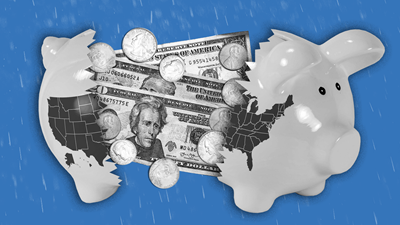Automatic Refund Policies Return Money to Taxpayers Even as State Budgets Tighten
High revenue collections drive refunds in Oregon and Colorado while states navigate fiscal strain

When state government revenue soars, it may feel to lawmakers like an unexpected opportunity to put money in a rainy day fund, jump-start new policy initiatives, or implement tax cuts.
But at least nine states have “automatic refund” laws that require the state government to return a portion of excess revenue to taxpayers if a certain threshold is reached. Designed to limit the growth of government spending, these laws can restrict lawmakers’ options and may also prevent states from using potentially temporary revenue increases to pay for recurring programs or tax cuts. And in uncertain economic times, they can exacerbate budget problems, decreasing available revenue or requiring states to dip into rainy day funds even as they issue refunds from prior years. Just two states—Colorado and Oregon—reached their threshold in fiscal year 2024 or 2025. California, Florida, Hawaii, Indiana, Massachusetts, Michigan, and Missouri are the other seven states that have laws requiring some type of revenue return.
Sometimes, automatic refund statutes can have ramifications beyond the fiscal year in which the state collected extra revenue. When refund conditions are immediately followed by hard times, states find themselves in a tough position—on the hook for refunds while facing a budget deficit. In a period of economic turbulence, policymakers in states that have automatic refund laws must take these policies into account as they navigate potential budget crunches.
‘Kicking’ back tax revenue in Oregon
In Oregon, the state’s refund law, known as the “kicker,” is triggered when final revenue collections in a biennium (two-year budget cycle) exceed the state’s original forecast by more than 2%. Oregon has crossed that threshold in every biennium since fiscal 2014-15, with revenue collections ranging from nearly 6% to more than 44% above original projections. But Oregon issues its refunds in the subsequent year, when residents file their tax returns—a potential risk for the state if fiscal conditions change.
That’s the scenario currently playing out as Oregon manages the effects of a multibillion-dollar surplus during the fiscal 2022-23 biennium. By law, Oregon had to refund $5.6 billion of that surplus in 2024, a record-high kicker. Personal income tax revenue collections then came in $53.2 million below the state’s forecast during the fiscal 2024-25 biennium, with Oregon’s Office of Economic Analysis citing “higher than expected refunds” as the cause of the decrease.
Budget forecasters incorporate the expected kicker into the state’s projections, but final accounting at the end of a biennium can still drive the total refund above expectations—leaving the state on the hook for a larger payout from previous years while it deals with the current year’s new trends and complications. For the fiscal 2026-27 biennium, which started July 1, 2025, a similar situation could arise. State economists found that 2025 revenue was lower than anticipated as of May and required a “mild downward revision” from the previous forecast, even after they had adjusted for payment of the kicker from the previous biennium. While Oregon lawmakers adjust to lower revenue forecasts, the state will have to pay the fiscal 2024-25 kicker in calendar year 2026—$1.6 billion. Meanwhile, Oregon and other states are confronting fiscal uncertainty amid tightened budgets and cuts to federal funding in addition to the loss of support from pandemic-era relief packages, which are expiring.
However, Oregon’s chief economist told Pew that he sees an upside to the timing of the refund, even if it means a decline in state revenue. “If it’s a tough year next year,” said Carl Riccadonna, “a rebate will help act as an [economic] stabilizer to some degree, in the same way that a tax cut or rebate is an economic stimulus.”
Colorado has a different mechanism but similarly frequent refunds
Colorado’s Taxpayer Bill of Rights (TABOR), which was enacted through a ballot initiative in 1992, limits the amount of revenue the state can retain and spend by adjusting the threshold annually for both inflation and population-related growth. When revenue collections exceed that limit, the state is required to issue a refund in the following fiscal year. Colorado’s revenue growth has exceeded the TABOR cap every year since fiscal 2018, with the exception of fiscal 2020. And the state appears to be on pace to do so again for fiscal 2025, which ended June 30, albeit with a much smaller total refund than in the last few years.
Tying tax refunds to inflation and population changes sometimes puts policymakers in the difficult position of having to issue refunds while wrestling with revenue losses, such as the loss of federal funding. Data collected by the Urban Institute shows that Colorado’s overall revenue fell 12% in the first quarter of 2025, compared with the first quarter of 2024, as the state issued TABOR refunds for fiscal 2024. For a time, the General Assembly’s Joint Budget Committee anticipated that budgeting challenges caused by TABOR refunds might extend through the end of this decade. In a February 2025 budget stress test, the committee explained that if TABOR refunds were paid out as expected, the legislature would need to use the state’s reserves to close the budget for the next five fiscal years. The general fund reserve “would be exhausted entirely before the end of the projection window,” the committee said.
But Colorado’s financial outlook has changed dramatically since that February 2025 stress test, and the state’s budget crisis may eliminate the TABOR refund for fiscal 2026. In early August, Governor Jared Polis (D) called a special session of the legislature to craft a response to the federal government’s recently enacted budget reconciliation bill, H.R. 1, which the governor says will result in the loss of more than $1 billion in revenue for Colorado this year. In a news release, the governor said, “Our TABOR refund has been taken away for this fiscal year.”
When automatic refund triggers are reached frequently, lawmakers may need to assess how the statute is functioning and whether it continues to support the state’s long-term objectives. Once enacted, however, automatic refund laws tend to stick. Taxpayer refunds have been a part of Colorado culture for more than 30 years, and attempts to repeal or amend the law have failed repeatedly. Most recently, voters rejected ballot initiatives in 2019 and 2023 that would, respectively, have eliminated the refund mechanism or increased the revenue cap to fund property tax relief.
In other states, lawmakers enact policy changes or take advantage of a different structure when handling taxpayer payouts
Unlike Oregon and Colorado, Massachusetts has rarely met its threshold for triggering automatic refunds. In 2022, lawmakers were caught off guard when surging tax revenue triggered a little-known provision in Chapter 62F for only the second time since it was enacted in 1986. The law required the state to return nearly $3 billion in excess revenue to taxpayers that year and delayed legislative plans for tax relief. Afterward, legislators made the refunds less likely by exempting surtax revenue from a new income tax from the 62F threshold.
In Alaska, there’s no automatic tax refund law, but lawmakers are similarly obligated to provide payouts to residents: Revenue from oil and gas leases is distributed in the form of annual dividend payments from the Alaska Permanent Fund. But in this case, lawmakers have flexibility. While the payout formula for annual dividend checks is governed by state statute, the governor and legislators have the authority to adjust the final payout.
This year, for example, Governor Mike Dunleavy’s proposed fiscal 2026 budget included the full dividend—nearly $3,900 per resident—and relied on budget reserves and cuts to close a $1.5 billion deficit. Instead, legislators reduced the dividend to $1,000 per resident as part of a package of solutions to close the budget gap without dipping into reserves.
Although the flexibility to adjust dividend payments allows Alaska to address budget shortfalls when revenue is low, routine reliance on that flexibility may mask long-term threats to fiscal sustainability. Alaska’s most recent long-term budget assessment, which was prepared in early 2025 by the Legislative Finance Division, noted that fiscal 2026 was the sixth consecutive year in which the governor’s budget included a deficit. The report predicted that deficits will continue for the next decade and that by fiscal 2031, Permanent Fund earnings will not be enough to close the projected deficit.
Final thoughts
Tight budgets make automatic refund policies harder to manage. Although the refunds can serve to limit state spending, such laws can also compete with other budget priorities, forcing lawmakers to strike a delicate balance.
Building refunds into budget forecasts can help policymakers anticipate and manage the consequences. Reassessing the conditions under which automatic refund statutes return money to taxpayers can also provide an opportunity for policymakers to evaluate whether these laws are still working for their states in uncertain times.
Page Forrest is an associate manager with The Pew Charitable Trusts’ Fiscal 50 project, and Sariah Toze is a senior associate with Pew’s state fiscal policy project.













